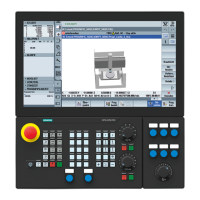Axis couplings
9.2 Curve tables (CTAB)
Job planning
510 Programming Manual, 07/2010, 6FC5398-2BP40-0BA0
9.2.4 Locking curve tables to prevent deletion and overwriting (CTABLOCK,
CTABUNLOCK)
Function
Locks can be set to protect curve tables against unintentional deletion and overwriting. Once
a lock has been set, it can be revoked at any time.
Syntax
Lock:
CTABLOCK(<n>)
CTABLOCK(<n>,<m>)
CTABLOCK(<n>,<m>,<memory location>)
CTABLOCK()
CTABLOCK(,,<memory location>)
Unlock:
CTABUNLOCK(<n>)
CTABUNLOCK(<n>,<m>)
CTABUNLOCK(<n>,<m>,<memory location>)
CTABUNLOCK()
CTABUNLOCK(,,<memory location>)
Significance
CTABLOCK
Command for setting a lock to prevent deletion/overwriting
CTABUNLOCK
Command for revoking a lock to prevent deletion/overwriting
CTABUNLOCK unlocks the curve tables locked with CTABLOCK. Curve
tables which are involved in an active coupling remain locked and
cannot be deleted. The lock with
CTABLOCK is unlocked as soon as
the lock applied due to the active coupling is unlocked when the
coupling is deactivated. This table can therefore be deleted. It is not
necessary to call
CTABUNLOCK again.
<n>
Number (ID) of the curve table to be locked/unlocked
When a curve table range
CTABLOCK(<n>,<m>)/CTABUNLOCK(<n>,<m>) is
locked/unlocked,
<n> is used to specify the number of the first curve
table in the range.
<m>
When a curve table range
CTABLOCK(<n>,<m>)/CTABUNLOCK(<n>,<m>) is
locked/unlocked,
<m> is used to specify the number of the last curve
table in the range.
<m> has to be greater than <n>.

